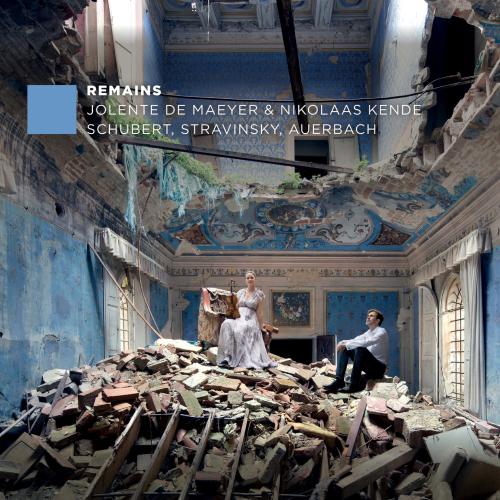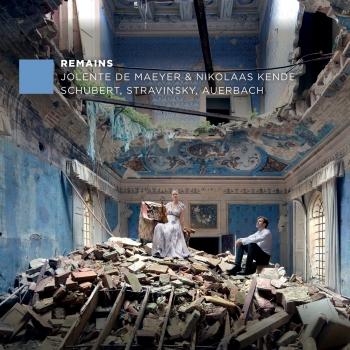
Album info
Album-Release:
2020
HRA-Release:
01.05.2020
Label: Evil Penguin Classic
Genre: Classical
Subgenre: Chamber Music
Artist: Jolente De Maeyer & Nikolaas Kende
Composer: Igor Stravinsky (1882–1971), Lera Auerbach (1973), Franz Schubert (1797-1828)
Album including Album cover
- Igor Stravinsky (1882 - 1971): Suite Italienne:
- 1 Suite Italienne: I. Introduzione 02:07
- 2 Suite Italienne: II. Serenata 03:16
- 3 Suite Italienne: III. Tarantella 02:10
- 4 Suite Italienne: IV. Gavotta con due Variazioni 03:14
- 5 Suite Italienne: V. Scherzino 01:16
- 6 Suite Italienne: VI. Minuetto e Finale 05:04
- Lera Auerbach (b. 1973): 24 Preludes for Violin and Piano, Op. 46:
- 7 24 Preludes for Violin and Piano, Op. 46: No. 2 in A minor 01:32
- 8 24 Preludes for Violin and Piano, Op. 46: No. 3 in G Major 02:04
- 9 24 Preludes for Violin and Piano, Op. 46: No. 4 in E Minor 01:02
- 10 24 Preludes for Violin and Piano, Op. 46: No. 8 in F-Sharp Minor 02:50
- 11 24 Preludes for Violin and Piano, Op. 46: No. 10 in C-Sharp Minor 01:24
- 12 24 Preludes for Violin and Piano, Op. 46: No. 11 in B Major 01:55
- 13 24 Preludes for Violin and Piano, Op. 46: No. 14 in E-Flat Minor 01:41
- 14 24 Preludes for Violin and Piano, Op. 46: No. 15 in C-Sharp Major 01:32
- Franz Schubert (1797 - 1828): Fantasy in C Major, D. 934 (Op. posth. 159):
- 15 Fantasy in C Major, D. 934 (Op. posth. 159): I. Andante moderato 03:31
- 16 Fantasy in C Major, D. 934 (Op. posth. 159): II. Allegretto 05:25
- 17 Fantasy in C Major, D. 934 (Op. posth. 159): III. Andantino 11:44
- 18 Fantasy in C Major, D. 934 (Op. posth. 159): IV. Allegro vivace 04:53
Info for Remains
Remains is the second album by Jolente De Maeyer and Nikolaas Kende, after Kreutzer Sonata (2016). It is a reflection on how the remains of the past inspire and influence our fast-changing world.
Both Stravinsky and Auerbach faced the difficulties of their time and society and chose to seek a future in a different world by deciding to leave their homeland, Russia. Stravinsky first became a French citizen in 1934 and, after fleeing the upcoming war in Europe to settle in America, an American citizen in 1939. Auerbach was still in her teens when she was one of the last artists to defect from the Soviet Union during a concert tour in America in 1991.
Although both composers found a unique, personal and visionary style in their compositions, often inspired by modern times and their new surroundings, one can hear how much inspiration they found in music from the past and in their Russian background. They were acclaimed for their style everywhere; Stravinsky became one of the most important composers of the 20th century and Auerbach is celebrated as one of the leading composers of the 21st century.
How different, by contrast, was Schubert's life. He never abandoned his city of birth, Vienna, and only received the acclaim he deserved after his death. He too dreamed of a better world, but was only to reach that place in his music. He built on the Viennese musical tradition and developed a unique style of composing, but his compositions were largely misunderstood during his short life. Schubert composed his Fantasy in the last year of his life, a year full of despair and rejection. One of the key elements of Schubert's Fantasy is a love song he had written earlier called Sei mir gegrüsst, based on a poem by Friedrich Rückert.
He must have identified with the bittersweet lyrics of the song, which have a thread of loneliness and abandonment. But whereas the song remains unclear if a positive ending is possible, the Fantasy itself ends in a triumphant style. Despite all the misfortune and misunderstanding that befell Schubert, a hope for a utopian world remained with him to the end. The music of all three composers inspires us to dream of other worlds, fantasy worlds with remains of the past. So do Henk Van Rensbergen's photographs of abandoned places.
As the music encourages us to relive history, so do his photos and locations, as if they are snapshots from the past; freezing history in time.
Whether it is a desolate power plant (our previous album's artwork), or a decayed Italian Palazzo (this album's artwork), the photographs ask us to question the story behind the image and strike us with their dramatic, yet poetic atmosphere. In today's turbulent world, the remains of the past remind us, inspire us, and give us hope for the future.
Jolente De Maeyer, violin
Nikolaas Kende, piano
Jolente De Maeyer
born in 1984 in Brussels, received her first violin lessons at the age of four. At fourteen she was invited by Yehudi Menuhin to pursue her musical studies at the Yehudi Menuhin School near London. Subsequently she studied with Natasha Boyarsky at Royal College of Music in London, Stephan Picard at Hochschule für Musik Hanns Eisler in Berlin and Augustin Dumay at the Queen Elisabeth Music Chapel in Belgium where she graduated in 2013
At the age of 6, she started participating in several national and international competitions and became the youngest laureate ever of the Jong Tenuto Competition. She was awarded with 1st Prizes at the Charles de Bériot Competition Brussels and in several international competitions as Cardona International Competition in Portugal, International Violin Competition Liana Issakadze in Russia (2004) and the Benjamin Britten International Violin competition in London (2005). She also became a semi-finalist in the Queen Elisabeth Competition in 2009.
As soloist, she performed with Brussels Philharmonic, Royal Flemish Philharmonic, Symfonieorkest Vlaanderen, Orchestre Royal de Chambre de Wallonnie, Orchestre Philharmonique de Liège, Kamerorkest Brugge, Nuove Musiche, Norfolk Symphony Orchestra, St-Petersburg State Academic Capella Chamber Orchestra and St-Petersburg State Academic Capella Symphony Orchestra, under conductors as: Philippe Herreweghe, Patrick Davin, Etienne Siebens, Pascal Rophé, Silveer Van den Broeck, Dirk Brossé, James Stobart, Michel Tilkin, Stefaan Fraas, Alexander Chernushenko and Rudolf Werthen.
In 2013 Jolente made her debut in America (Texas) with the Waco Symphony Orchestra and Stephen Heyde, where she performed Tchaikovsky violin concerto. This was followed by a recital tour with Nikolaas Kende.
In Belgium Jolente has performed regularly in halls like Bozar, Flagey, the Elisabeth Hall, de Singel and the Roma and she played concerts in festivals such as the Festival van Vlaanderen, Festival de Montpellier and Menton. Furthermore, she has performed in countries such as Russia, France, Italy, Portugal, Croatia, The Netherlands, Spain, as well as in London's Wigmore Hall, Royal Albert Hall and at the Gstaad Menuhin Festival in Switzerland.
Being an outstanding chamber music performer she formed the duo with pianist Nikolaas Kende. Together they founded the Rubens Ensemble in 2007.
Nikolaas Kende
born in Antwerp in 1981, studied at the Antwerp conservatory with his parents, Heidi Hendrickx and Levente Kende and at the Amsterdam conservatory with Jan Wijn. Eventually he started an intense cooperation with Elisso Virsaladze at the Hochschule für Musik und Theater München and at the Scuola di Musica Fiesole. In addition he was taught by people like Dmitri Bashkirov, Aldo Ciccolini, Murray Perahia, Dmitri Alexeev and Radu Lupu. Whilst training as a pianist he was given the 2013 “Oranjebeurs” and grants by the Deutscher Akademischer Austauschdienst in 2004 and 2005.
While still young Nikolaas Kende won several competitions: the Cantabile competition (Antwerp, 1998), the EPTA international competition for piano duos (1999), the Axion Classics competition (Brussels, 1999), the Stefaan de Jonghe competition (Aalst, 2000) and the Tenuto competition (Brussels, 2002).
In 2002 he was a laureate of the Belgian Foundation for Young Soloists, in 2004 he came second in the competition of the Young Pianist Foundation in The Hague, and in 2005 he won the PianistenParade in ’s-Hertogenbosch, in which he also obtained the prizes of the public and of the press. In the next year he was a laureate of the th music competition of the Ghent Rotary Club and he won the 57th competition organized by the Friends of the Concertgebouw Amsterdam and the Royal Concertgebouw Orchestra. In this competition he won on top the Prize given by the press and the AVRO Klassiek prize, the latter enabled him to record a CD.
In 2007 he reached the semi-finals of the Queen Elisabeth Competition and became a laureate of the Young Soloists Competition organized by the Royal Flemish Philharmonic, conducted by Philippe Herreweghe. Still young, he began his international career with invitations to France, Germany, Spain, Portugal, Italy, Austria and Bulgaria. He made his American debut (California and Texas) in 2009 with lavish press reviews and an invitation for a another touring project in 2013.
He has performed on all the important Belgian concert stages. Recently, concerts have taken him to Spain, the Czech Republic, Romania, the Netherlands Antilles and the festivals of Montpellier, Menton and Vexin in France.
He has played concertos by Bach, Mozart, Beethoven, Chopin, Brahms, Tchaikovsky, Poulenc, Ravel, Rakhmaninov and Bartók, with orchestras such as the Brussels Philharmonic, the Orchestre Royal de Chambre de Wallonie, the Royal Flemish Philharmonic and the Flanders Symphony Orchestra conducted by Etienne Siebens, Koen Kessels, Ivo Venkov, Jurgen Küssmaul, Ernst van Tiel, Daniele Callegari, Dirk Vermeulen, Paul Goodwin, Stephen Heyde and David Angus among others.
Nikolaas Kende is also an avid chamber musician. Since 2003 he has formed a duo with violinist Jolente De Maeyer and was a co-founder of the Rubens Ensemble in 2007. He was associated with the Narziss und Goldmund Trio for the recording of Schubert’s Piano Trio (D. 929) for Phaedra Classics, the label he recorded also a cd with solo piano works by Johannes Brahms. He has made numerous recordings for radio (the Belgian classical channel Klara, RTBF, AVRO, Radio Romania, France Musique, WDR) and television.
In 2015, Nikolaas was appointed professor of piano at the Royal Conservatory of Antwerp.
Future projects include recital tours, both solo and in duo with Jolente, in Canada, America, South-Africa and China.
This album contains no booklet.











